Nombre:
Estatua de Padmasambhava en Namchi
Otro:
Localización:
View Larger Map
Récord: 36 m
Tipo: Estatuas
Categoría: Guru Rinpoche
Foto:
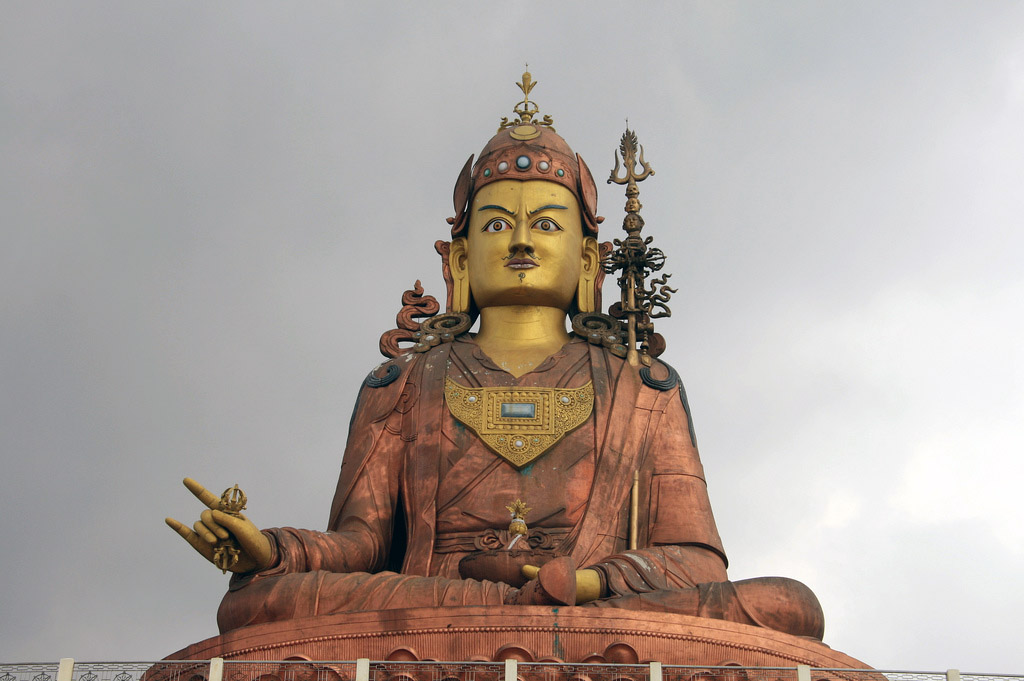
Voto:
Continente: Asia
País: India
Localización: Namchi, Sikkim
Año: 2004
Estado: Terminado
Descripción:Guru Padmasambhava es el maestro de la Escuela Vajrayana o Escuela Tántrica de budismo en Tíbet.
Buda Shakyamuni predijo muchas veces sobre Guru Padmasambhava. Hay diecinueve predicciones diferentes en los sutras y tantras en relación con Guru Padmasambhava. En estas profecías Buda Shakyamuni expresó que él regresaría en la forma del Buda Padmasambhava y que brindaría más enseñanzas sobre el tantra Vajrayana.
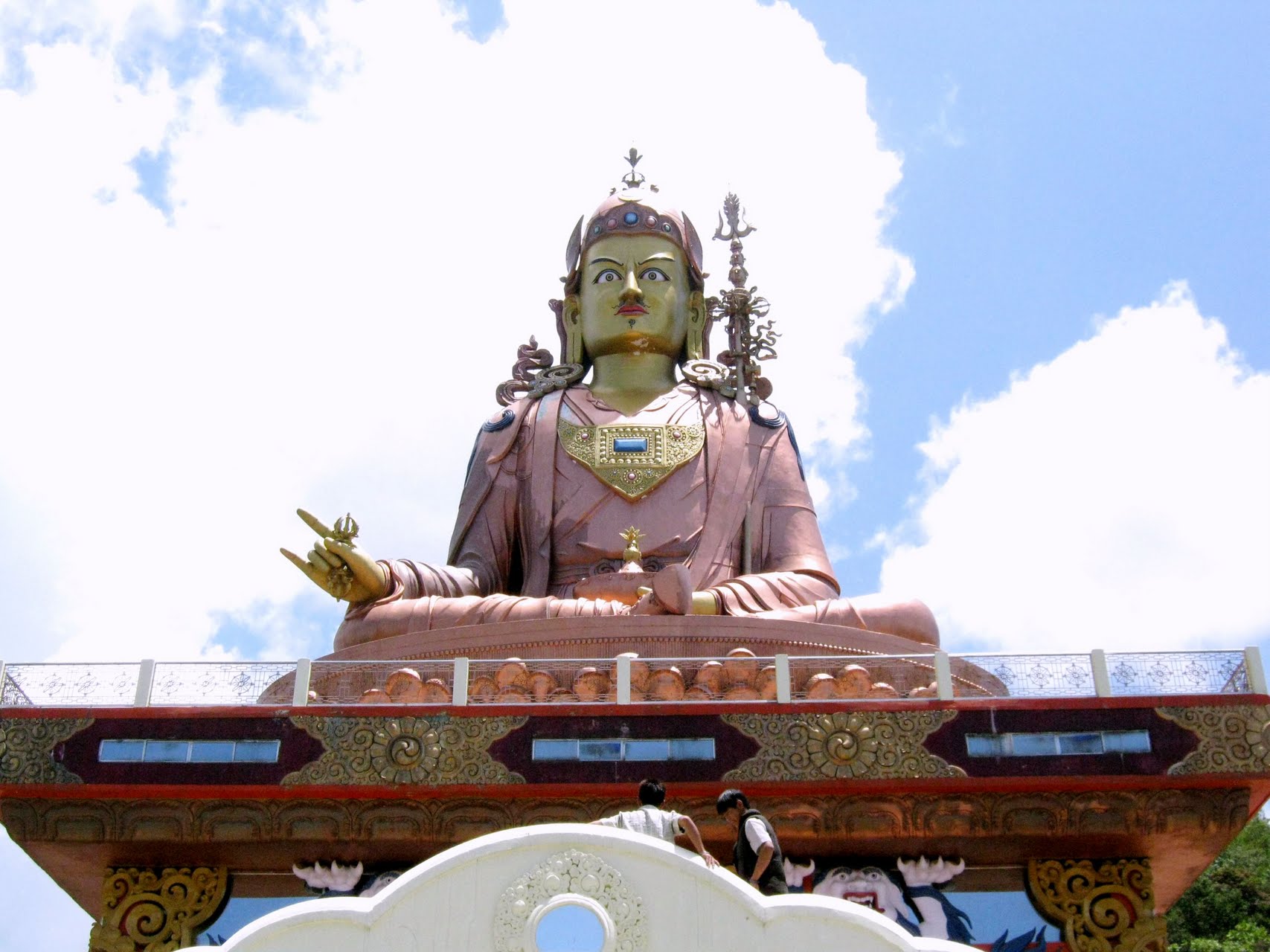
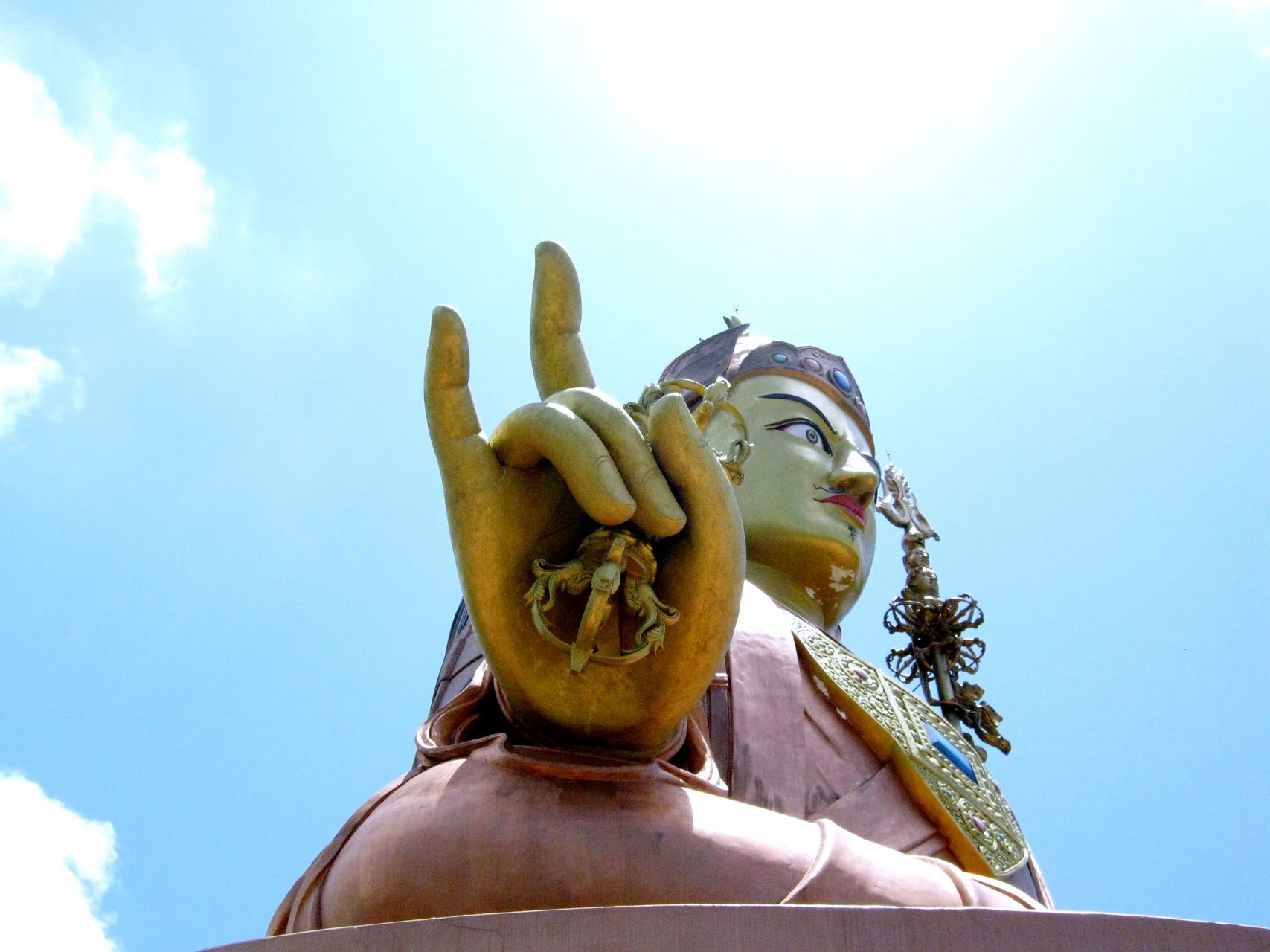
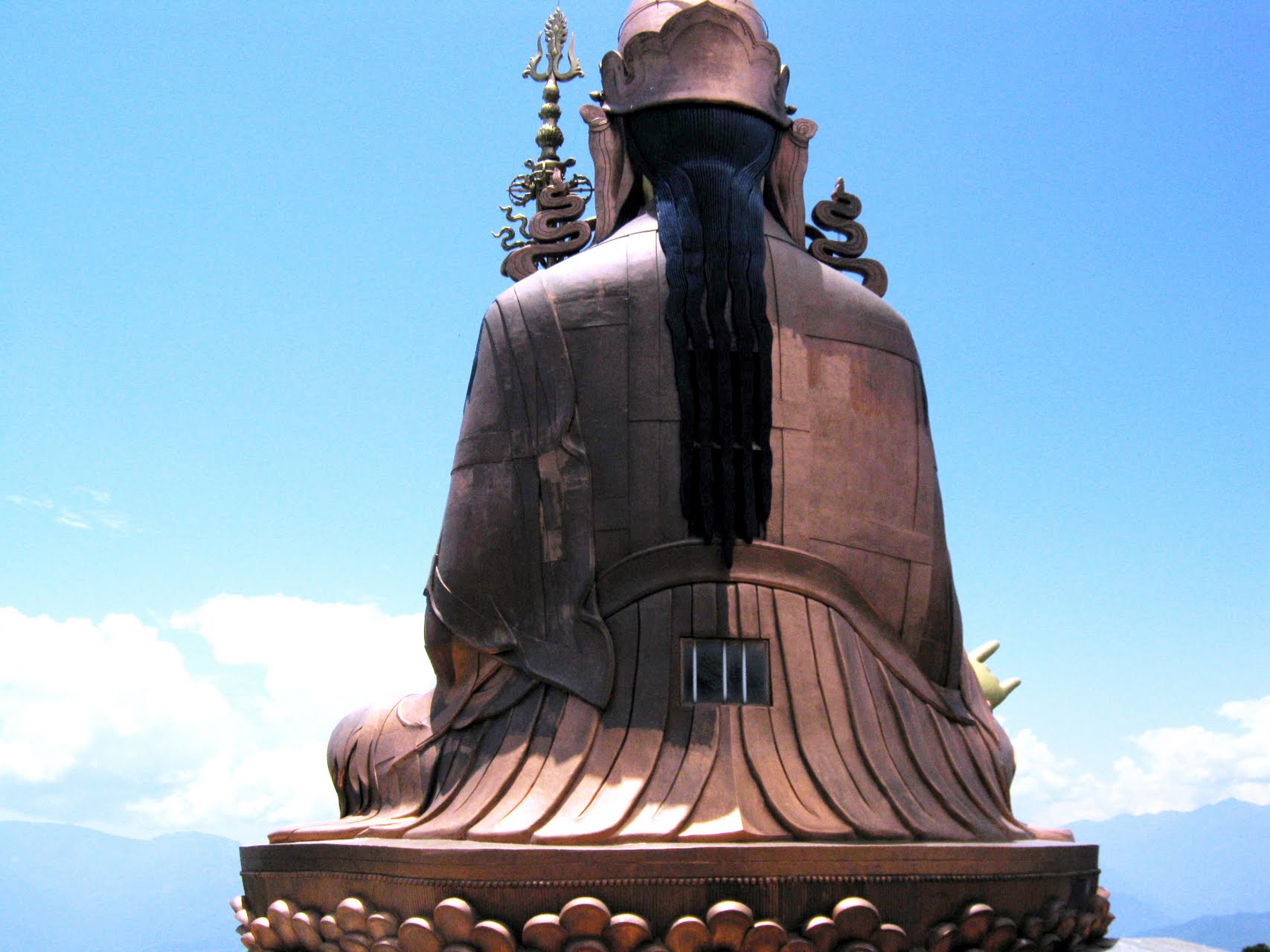
Como fue predicho por Buda Shakyamuni, Guru Padmasambhava apareció milagrosamente en un loto al noroeste de la India, en un país llamado Uddiyana. Apareció ocho años después de la muerte de Buda Shakyamuni. Cuando Guru Padmasambhava apareció, muchos reyes y ministros aprendieron de él y uno de estos reyes fue donde el Guru Padmasambhava y le hizo cinco preguntas. Le preguntó: " ¿Cuál es tu nombre?, ¿ De dónde vienes?, ¿ Cuál es el nombre de tu padre y de tu madre?, ¿ Qué tu comes?, ¿ Cuál es tu profesión?, y ¿ por qué estas aquí?" Guru Padmasambhava contestó: "El país de donde vengo es el estado no nacido, Dharmadhatu. El nombre de mi padre es Buda Samantabhadra y el de mi madre Samantabhadri." Cuando el rey preguntó: " ¿ Qué tu comes? " , él dijo: " Yo como pensamientos de dualidad. " Cuando preguntó sobre su trabajo, él dijo que trabajaba para todos los seres sensibles. Cuando el rey escuchó esas contestaciones se sintió complacido y le pidió a Guru Padmasambhava que viviera en su palacio y que fuera como su hijo. Así que Guru Padmasambhava fue al palacio y permaneció por muchos años. Esto fue alrededor de 500 años después de Cristo.
Cuando Guru Padmasambhava dejó el palacio, cumpliendo por completo una profecía de Buda Vajrasattva, fue a muchos lugares, todos a través de la India. Particularmente a los cementerios. Hizo varias clases de meditaciones en todos los grandes cementerios, aún cuando él era ya un ser iluminado. Hizo esto para demostrar prácticas meditativas que llevan a la iluminación. Se presentó en muchas manifestaciones diferentes y trabajó en distintos lugares. Algunos reyes y ministros no entendieron sus enseñanzas y se sintieron celosos de sus actividades. Decidieron castigarlo sentándolo en el fuego o tirándolo al río. Cuando ellos intentaron esto el fuego se convirtió en agua y cuando lo pusieron en el río, él brincó y bailó en el aire. Al final, estas cosas hicieron que muchos seres sensibles abrieran sus corazones a la iluminación.
En otra ocasión un rey del norte de la India, que envidiaba a Guru Padmasambhava, hizo que lo tiraran a un inmenso fuego; pero luego de tres días el fuego se tornó en luz y Guru Padmasambhava estaba sentado justo en el centro de la luz en un loto. El lugar donde sucedió esto es muy famoso. Peregrinos todavía visitan este lago, llamado Tso Padma o Lago del Loto, localizado en el norte de la India.
Quizás ustedes hayan oído acerca del rey Ashoka. El rey Ashoka fue uno de los reyes más famosos en la historia de la India, en un momento dominó la mayor parte de Asia. Él era muy cruel y mató a cientos de seres sensibles. Mas tarde cambió su mente hacia la no-violencia y prometió que nunca más tocaría su espada. Cambió en su manera de pensar y comenzó a trabajar para el Dharma. Trajo maestros y ayudó a establecer el Dharma del Buda en todas partes del mundo. Fue Guru Padmasambhava quien le enseñó sobre la no-violencia. Ashoka construyó un millón de stupas en diferentes lugares de su reino.
Guru Padmasambhava llegó al Tíbet por invitación del rey Trisong Deutsen a mediados del siglo octavo. Este rey era el líder más poderoso de Asia en esa época y estaba completamente dedicado al establecimiento del Dharma en el Tíbet. Guru Padmasambhava trajo las enseñanzas tántricas al Tíbet, en donde él enseñó al rey y a muchos otros, a través de la siembra de la semilla Vajrayana del Buda. Como resultado de esto, el Tíbet comenzó a llenarse de hombres y mujeres realizados. A causa del esfuerzo de Guru Padmasambhava y del Rey, el Tíbet se convirtió en uno de los países de mayor riqueza en el mundo, en términos de enseñanzas budistas. Esta riqueza es la bendición de Guru Padmasambhava, así como la de otros grandes maestros, que son los fundadores del budismo tibetano.
Mientras Guru Padmasambhava estuvo en el Tíbet cientos de hombres y mujeres se iluminaron. Guru Padmasambhava impartió la enseñanza del Vajrayana de acuerdo con la necesidad y capacidades de cada cual. Él brindó enseñanzas, autorizaciones y trasmisiones que ayudaron a muchos tibetanos a alcanzar la iluminación. Entre los estudiantes del Guru Padmasambhava están los Nueve Hijos del Corazón, los Ochenta Grandes Siddhas, los Treinta y cinco Grandes Yoguis y las Treinta y siete Grandes Yoguinis. Muchos de los maestros famosos de ese siglo lograron la realización como resultado de sus enseñanzas.
Guru Padmasambhava dio muchas enseñanzas, las cuales escondió en diferentes partes del Tíbet para las generaciones futuras. El trabajó con la ayuda de la muy famosa Dakini de Sabiduría, Lady Yeshe Tsogyel, quien fue una de sus más famosas estudiantes. Juntos, escondieron muchas enseñanzas y objetos rituales. El también ocultó muchas predicciones, incluyendo las predicciones generales para el mundo y las predicciones particulares para los tibetanos. El predijo lo que pasaría generación tras generación, y dijo como resolver muchos problemas. Estas enseñanzas han sido muy beneficiosas por muchos siglos. Las predicciones son muy precisas y exactas. En occidente las personas han escuchado la predicción de que cuando el ave de hierro volara en el cielo el Dharma iría al occidente. El hizo muchas predicciones exactas y precisas.
Guru Padmasambhava permaneció en el Tíbet ciento once años.
http://www.oshogulaab.com/BUDISMO_TIBETANO/padmasambava.htm
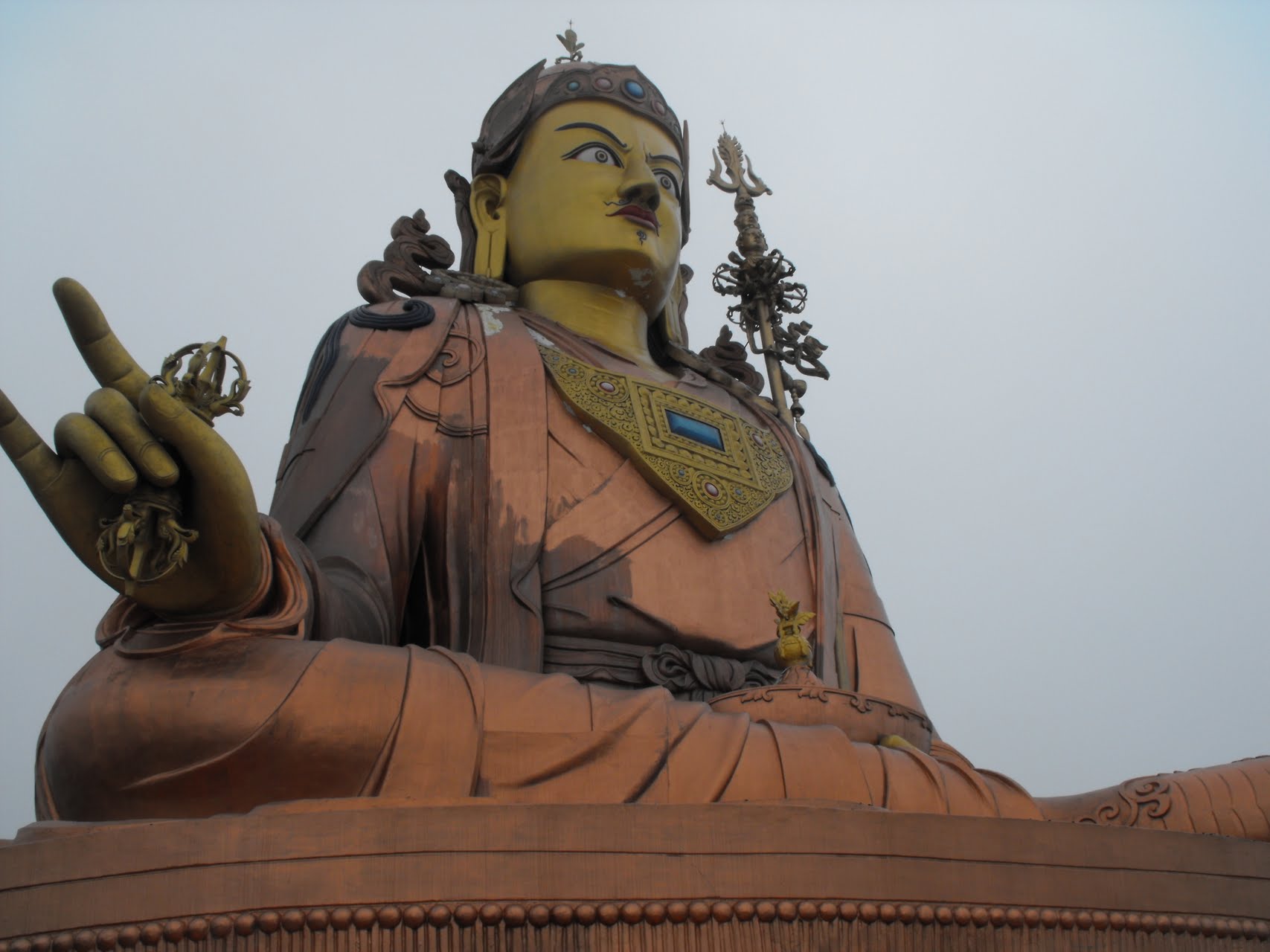
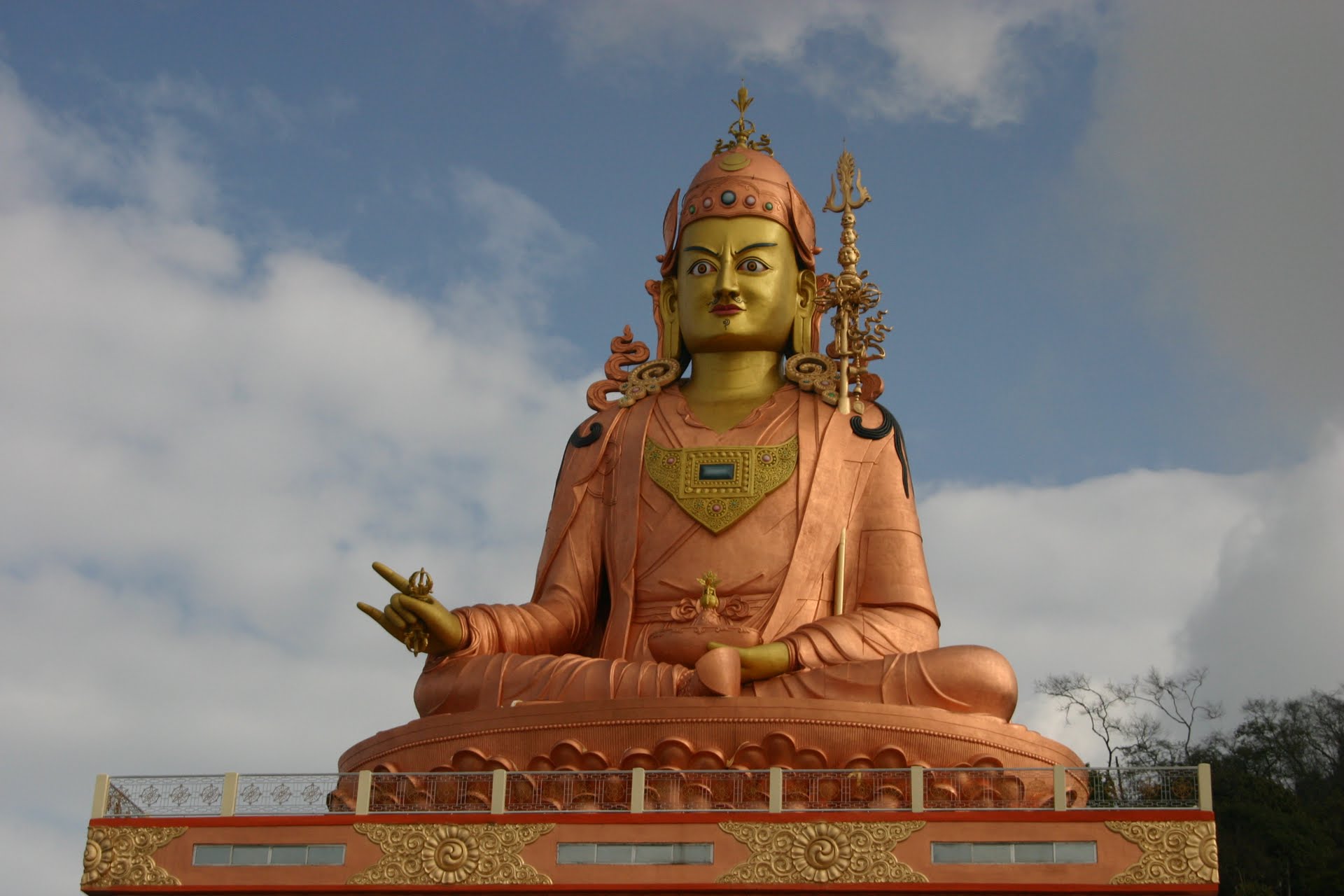
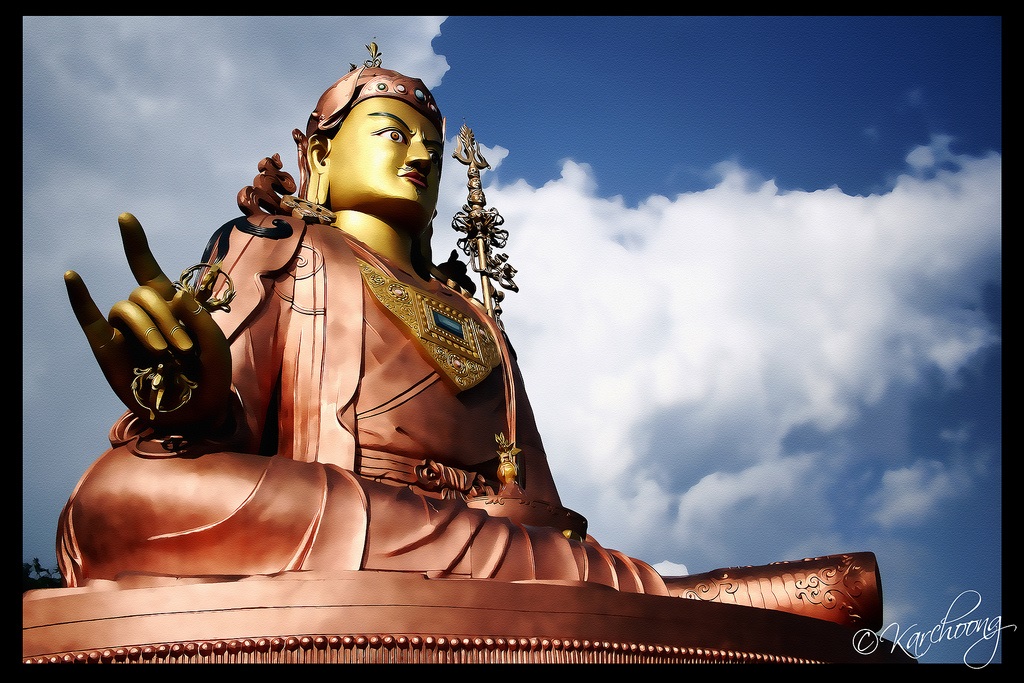
GURU RINPOCHE (PADMASAMBHAVA)
Date: 2009.08.15
About Guru Rinpoche according to Jamgon Kongtrul
The following is a short story of Guru Rinpoche, also referred to as Padmasambhava or Padmakara in the text, extracted from the Precious Garland of Lapis Lazuli, a collection of life stories of the 108 main tertöns written by Jamgon Kongtrul the First and found in Volume I of his Treasury of Precious Termas called the Rinchen Terdzod. Rinchen Terdzod is a highly revered and widely practiced set of historic Sadhanas and Terma practice cycles and commentaries which was envisioned by Rime movement founders and compiled mainly by Kongtrul:
“Padmakara has influenced countless beings through the Vajrayana teachings and in particular through the activity of the profound terma treasures. This great master was not an ordinary person on the path or just a noble being on one of the bodhisattva bhumis but an emanation of both Buddha Amitabha and Shakyamuni who appeared in order to tame the human beings and spirits difficult to convert. Even the great bodhisattvas are incapable of fully explaining his life example but in brief I will narrate it as follows:
In the dharmakaya realm of the Luminous Vajra Essence he has by nature attained perfect enlightenment since the very beginning as the liberated ground of primordial purity. He is renowned as the original protector, Unchanging Light. In the self-manifest sambhogakaya realm of the Thunder of the Drum of Perfection, he spontaneously manifested as the boundless wisdom array of the five families of Buddha Immense Ocean possessing the five certainties. As the external manifestation of this self-appearing display, in the countless sceneries of bodily forms in buddhafields of the five families consisting of the semi-manifest natural nirmanakaya realms of Mahabrahma, he appears to all the bodhisattvas on the ten bhumis. Since these all are the cloud banks of Guru Rinpoche’s wisdom display, the ‘inexhaustible wheel of adornment,’ he is known as the All-Holding Lotus. By the power of these wisdom displays he appears in countless worlds of the ten directions as the magical apparition of nirmanakayas who tame beings. In particular, it is taught that only in this Saha world-system he illuminates fifty worlds with the lamp of the teachings of Sutra and Tantra appearing as the eight manifestations to tame beings in the different parts of the world.
The Dakini Yeshe Tsogyal had a vision in which she saw a manifestation of Guru Rinpoche called Immense Vajra Ocean in the direction to the east. Each of the pores in his body held one billion realms and in each realm there were one billion world systems. In each of these world systems there were one billion Guru Rinpoches who each created one billion emanations. Each of these emanations carried out the activity of taming one billion disciples. She then saw the same display in each of the other directions and in the center. In this world of Jambudvipa, Guru Rinpoche is known as just one nirmanakaya who tames beings but according to the different capacities and giftedness of people he is perceived in various ways. The history of the Oral Transmission of Kilaya and most Indian sources explain that he was born as the son of a king or a minister in Uddiyana; while the terma treasures for the most part narrate that he was miraculously born. In some texts he is said to have appeared from a bolt of lightning at the summit of Mount Malaya. Each of these wondrous stories differ in many ways. This is indeed a topic that lies far beyond the reach of an ordinary person’s intellect.
I shall now limit the explanation down to a mere seed, the life of Guru Rinpoche according to miraculous birth as it appears in the terma teachings:
In the land of Uddiyana situated to the west of Bodhgaya there was an island in a huge lake on which appeared a multicolored lotus flower through the blessings of the buddhas. Buddha Amitabha sent from his heart center a golden vajra marked with the letter HRIH into the bud of this lotus flower which miraculously turned into a small child eight years of age holding a vajra and a lotus and adorned with the major and minor marks. The child remained there teaching the profound Dharma to the devas and dakinis on the island. At that time Indrabodhi, who was the king of the country, had no sons. He had already emptied out his treasury by making offerings to the Three Jewels and giving alms to the poor. As a last resort, in order to find a wish-fulfilling jewel he embarked on a journey with his minister Krishnadhara on the great lake. On their return first Krishnadhara and later King Indrabodhi met the miraculous child. The king regarded him as an answer to his prayers for a son and brought him to the palace where he was given the name Padmakara, the Lotus Born. Padmakara was then asked to sit on a throne made of precious gems and given lavish offerings by all the people.
The prince grew up, bringing countless beings to maturation through his youthful sports and games. He married Prabhadhari and ruled the kingdom of Uddiyana in accordance with the Dharma. At that time he perceived that he would be unable to accomplish the immense welfare of other beings by governing a country so he asked Indrabodhi permission to leave which was not granted. In an act of play, he then pretended that his trident slipped out of his hand. It fell and killed the son of one of the ministers. He was then sentenced to be expelled to a charnel ground. He remained in Cool Grove, Joyful Forest and Sosaling, engaging in the conduct of yogic disciplines. During this time he received empowerment and blessings from the two dakinis Tamer of Mara and Sustainer of Bliss. When bringing all the dakinis of the charnel grounds under his command, he was known as Shantarakshita.
Padmakara returned to Uddiyana, to the island in Lake Danakosha where he practiced Secret Mantra and the symbolic language of the dakinis through which he brought the dakinis on the island under his command. He then practiced in the Rugged Forest and was blessed with a vision of Vajra Yogini. He bound under oath all the nagas of the lakes as well as the planetary spirits and was invested with supernatural powers by all the dakas and dakinis. Thus he became renowned as Dorje Drakpo Tsal, Wrathful Vajra Power.
http://www.gurupadmasambhava.org/the-meaning-of-the-vajra-guru-seven-line-prayer-to-guru-rinpoche
4| Statue of Padmasambhava, Namchi, Sikkim - 118 ft
Another statue of Guru Rinpoche located in Namchi in Sikkim also founds a mention in the list. The place is famous among Buddhist and is one of the major pilgrimage center in Sikkim.
The statue was opened for public in 2004 and the tourist visiting the place have since then only increased.
http://kannanwrites.hubpages.com/hub/Largest-Statues-of-India
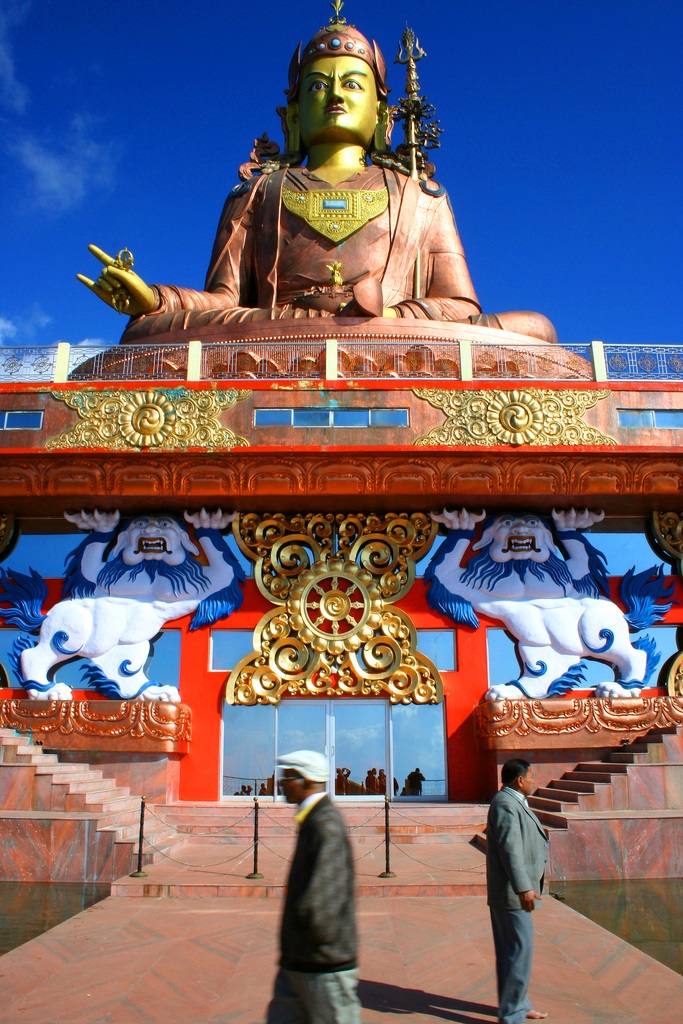
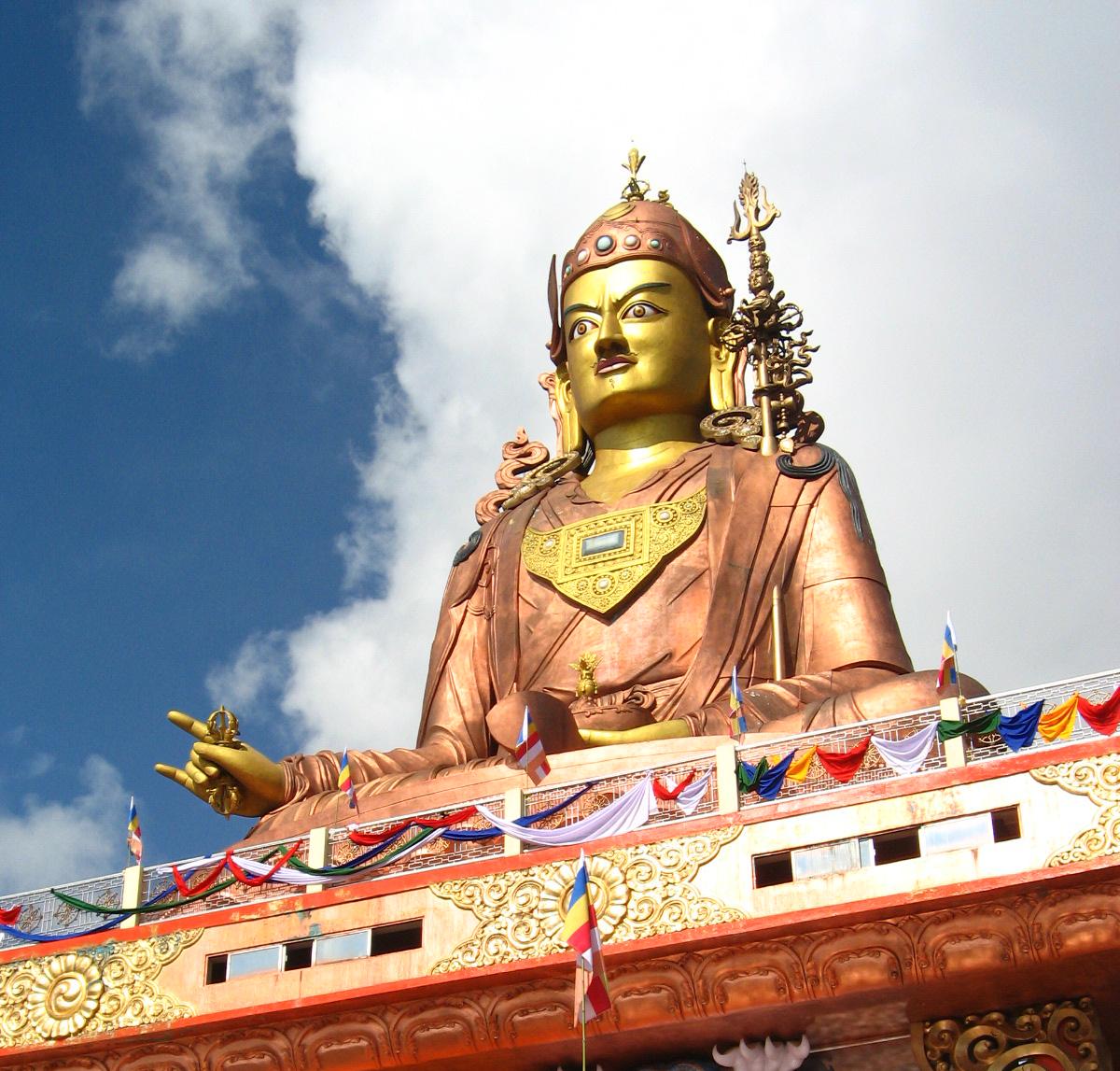
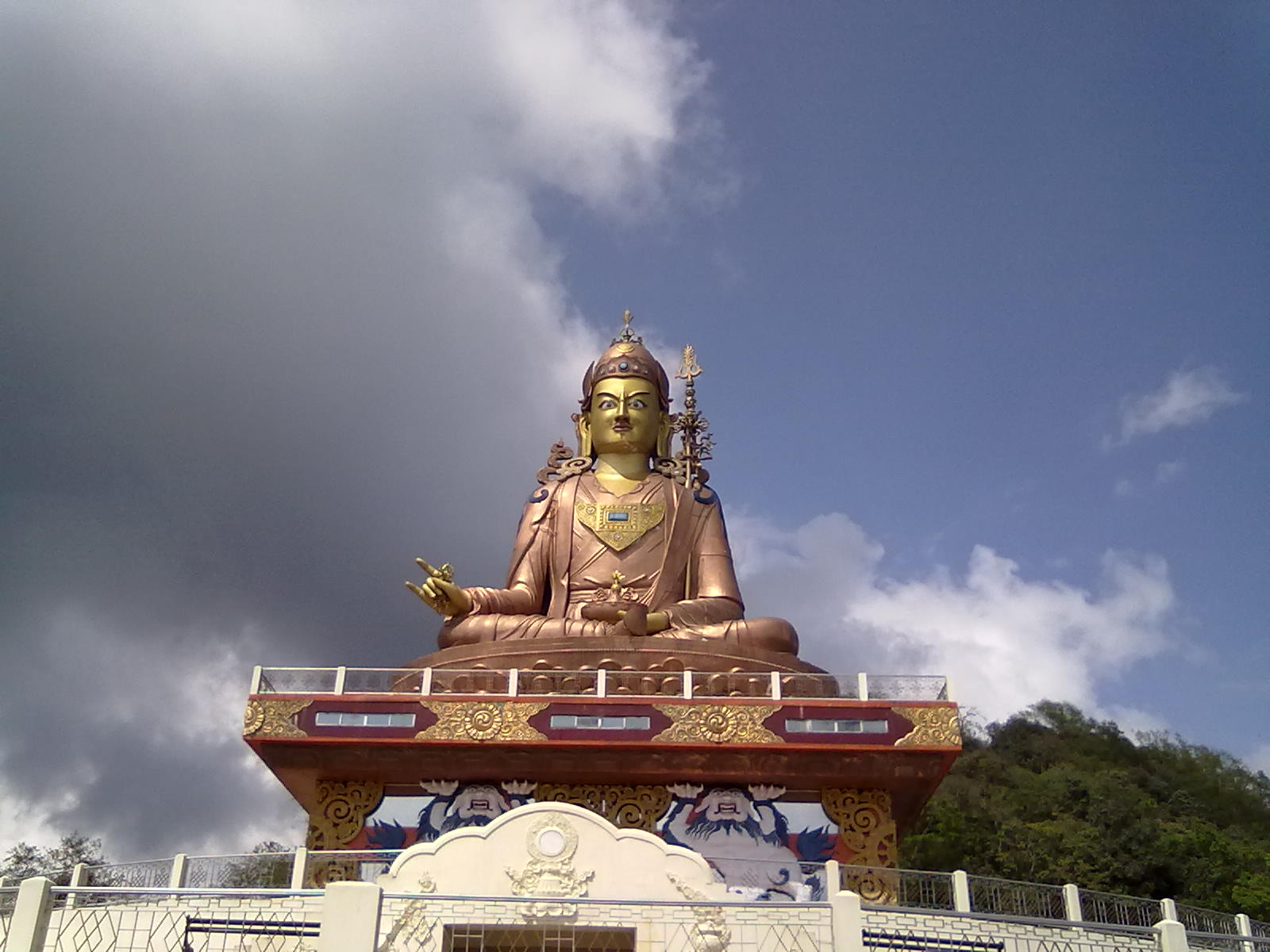
Namchi is fast becoming a major tourist spot and pilgrimage centre. The Namchi monastery, Ralong monastery and Tendong Hill are important Buddhist pilgrimage centres. The world's largest statue (at 118 feet) of the Buddhist Padmasambhava, also known as Guru Rinpoche, the patron saint of Sikkim, is on the Samdruptse hill (The Wish Fulfilling well) opposite Namchi. It was completed in February 2004. It is also said that the Samdruptse hill is actually a Dormant Volcano. Myths say that the buddhist monks have been going on top of the hill and offering prayers to the volcano to keep it calm. There is also a Rock Garden just few kilometers up from the town on the way to Samdruptse. The Rock Garden displays a wide variety of Flora and is a local recreation and picnic spot. It offers a magnificent view of Mt. Kanchendzonga (aka Mt. Kanchenjanga, the world's third highest peak).
http://en.wikipedia.org/wiki/Namchi
http://phakchokrinpochemexico.blogspot.com.es/2011/01/dia-de-guru-rimpoche-enero.html
http://www.panoramio.com/photo/38042863
http://kannanwrites.hubpages.com/hub/Largest-Statues-of-India
http://adriancyclingtosikkim.blogspot.com.es/2009/04/200409.html
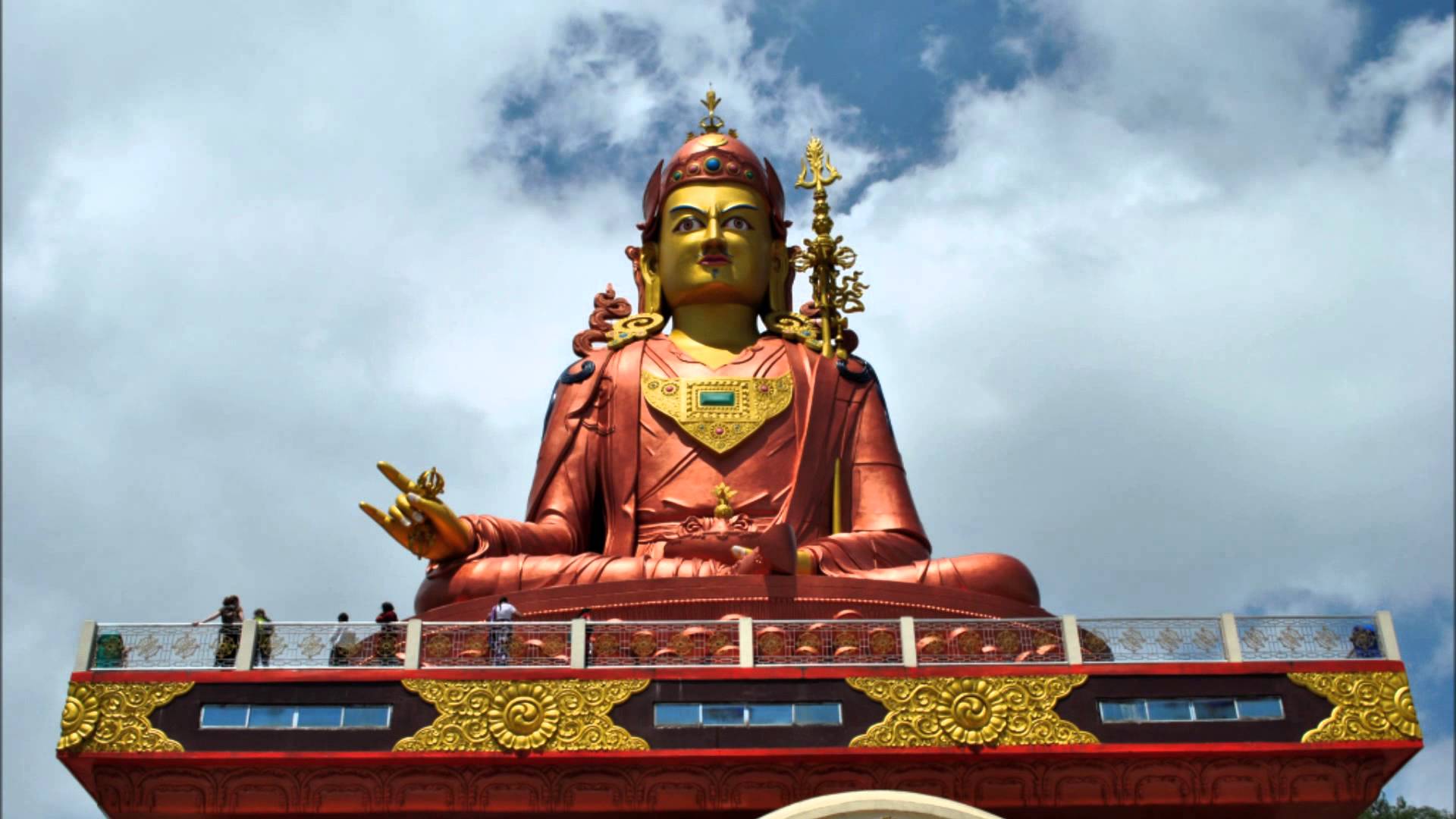
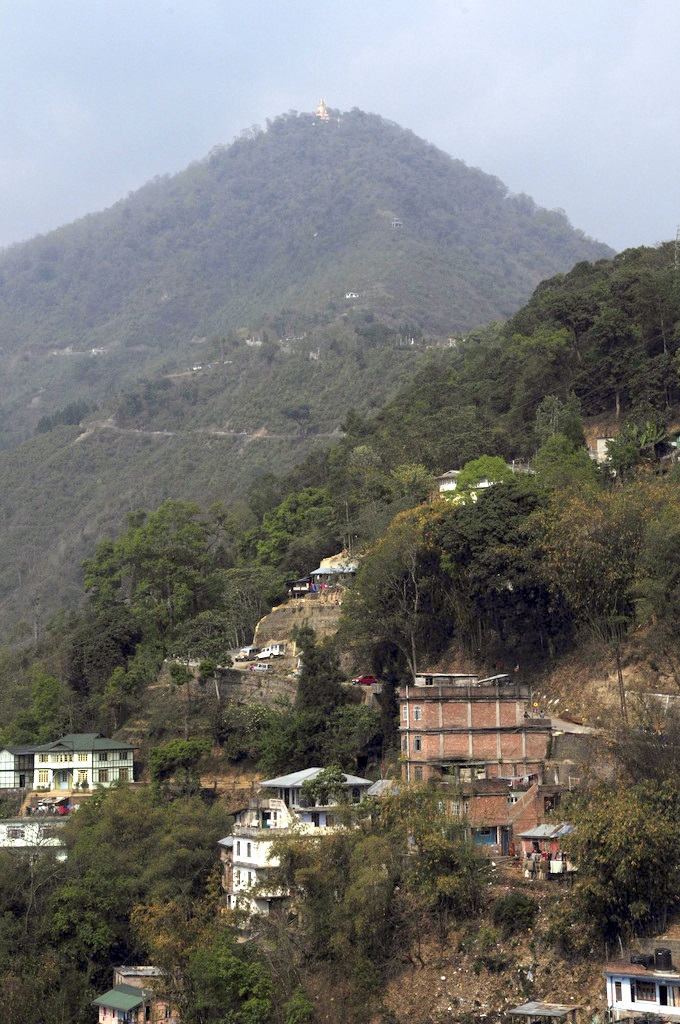
Vídeo:
Web recomendada: http://www.gurupadmasambhava.org/
Contador: 7104
Inserción: 2013-06-11 12:59:08
Lugares a visitar en un radio de 100 km (en línea recta)
Mapa de los lugares a 100 km (en línea recta)
Mostrando Registros desde el 1 hasta el 0 de un total de 0
Visitas |
Más visitados Basílica de San Marcos 153848 Catedral de Notre Dame (París) 143320 Torre de Pisa 130848 Monte Saint-Michel 100020 Presa de las Tres Gargantas 80213 |
Incorporaciones |
Comentarios hazola Cúpula de la Roca gracias me... gera Buenos Aires las mejores fotos de la mejor ciudad del... Daniel M. - BRASIL San Francisco ... PEQUE Presa Chicoasén SERA QUE ALGUIEN ME PUEDE DAR MAS INFORMACIÓN DE ESTE PROYECTO ESTUDIO EN LA UNACH Y ES PARA UN... Mery Huaca Pucllana Muy interesante, muy buena la información y... |
 Tweet
Tweet


